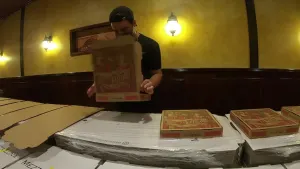More Stories
Anyone who has spent any time at the Jersey Shore knows about the distinctive gravel many homeowners use to cover their yards.
The gravel is known as “Jersey Yellow” or “Jersey Gravel” and News 12 New Jersey’s Brian Donohue can’t get enough of the stuff. He went in search of the origins of why Jersey Shore residents use this type of gravel in their yards.
“Let’s go back about 10 million years,” says Kenneth Miller, graduate program director at Rutgers’ Department of Earth and Planetary Science.
Miller says that it starts back when the Appalachian Mountains were as tall as the Himalayas are today. But bit by bit, they crumbled into the sea.
“Stony Mountain, Apple Pie Hill, Mount Holly – you drive through any of the great mountains of South Jersey -- all those hills are held up by gravel,” says Miller.
When humans migrated to the area and South Jersey sands became a source for glass-making concrete industries, a lot of the gravel was a byproduct – one that no one knew what to do with.
“And so, the gravel was in the way. You just sift it out. It’s a byproduct that actually became quite valuable,” says Miller.
Donohue found out that at some point, a smart salesperson began advertising the gravel as a good cover for homes along the shore where the grass doesn’t grow as well.
The stones are dredged from the waters of southern New Jersey mines like Tuckahoe Sand and Gravel. The earth is dredged up pumps to a tower and sifted into fine sands for concrete and gravel for driveways.
The gravel is famous around the Jersey Shore – the sound it makes is the bane of any teenager trying to sneak in after curfew, and causes those who walk on it barefoot to wince in pain.
And as another summer comes to an end, more than a few pieces of stone will go home in the pockets of Jersey Shore visitors as a reminder of the beach in the winter – and that’s positively New Jersey.
More from News 12

Pizza delivery driver attempts to break world record for fastest pizza box folding
2:39

Documentary about infamous Action Park becomes 1 of the most watched films on HBO Max
2 days

Oakland’s ‘Vault’ houses your old school records, opera costumes and even Miss Piggy
1 day, 17 hours

Silly Walk Zone: How one family is bringing the neighborhood together in the pandemic
1 day, 21 hours

Octogenarian sets new records by becoming firefighter at age 79
1 day, 23 hours
